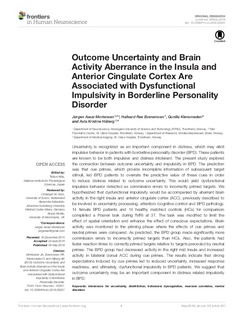| dc.contributor.author | Mortensen, Jørgen Assar | |
| dc.contributor.author | Evensmoen, Hallvard Røe | |
| dc.contributor.author | Fosse, Gunilla Klensmeden | |
| dc.contributor.author | Håberg, Asta | |
| dc.date.accessioned | 2020-03-05T13:02:43Z | |
| dc.date.available | 2020-03-05T13:02:43Z | |
| dc.date.created | 2016-06-21T12:08:40Z | |
| dc.date.issued | 2016 | |
| dc.identifier.citation | Frontiers in Human Neuroscience. 2016, 10 (207), . | nb_NO |
| dc.identifier.issn | 1662-5161 | |
| dc.identifier.uri | http://hdl.handle.net/11250/2645516 | |
| dc.description.abstract | Uncertainty is recognized as an important component in distress, which may elicit impulsive behavior in patients with borderline personality disorder (BPD). These patients are known to be both impulsive and distress intolerant. The present study explored the connection between outcome uncertainty and impulsivity in BPD. The prediction was that cue primes, which provide incomplete information of subsequent target stimuli, led BPD patients to overrate the predictive value of these cues in order to reduce distress related to outcome uncertainty. This would yield dysfunctional impulsive behavior detected as commission errors to incorrectly primed targets. We hypothesized that dysfunctional impulsivity would be accompanied by aberrant brain activity in the right insula and anterior cingulate cortex (ACC), previously described to be involved in uncertainty processing, attention-/cognitive control and BPD pathology. 14 female BPD patients and 14 healthy matched controls (HCs) for comparison completed a Posner task during fMRI at 3T. The task was modified to limit the effect of spatial orientation and enhance the effect of conscious expectations. Brain activity was monitored in the priming phase where the effects of cue primes and neutral primes were compared. As predicted, the BPD group made significantly more commission errors to incorrectly primed targets than HCs. Also, the patients had faster reaction times to correctly primed targets relative to targets preceded by neutral primes. The BPD group had decreased activity in the right mid insula and increased activity in bilateral dorsal ACC during cue primes. The results indicate that strong expectations induced by cue primes led to reduced uncertainty, increased response readiness, and ultimately, dysfunctional impulsivity in BPD patients. We suggest that outcome uncertainty may be an important component in distress related impulsivity in BPD. | nb_NO |
| dc.language.iso | eng | nb_NO |
| dc.publisher | Frontiers Media | nb_NO |
| dc.rights | Navngivelse 4.0 Internasjonal | * |
| dc.rights.uri | http://creativecommons.org/licenses/by/4.0/deed.no | * |
| dc.title | Outcome uncertainty and brain activity aberrance in the insula and anterior cingulate cortex are associated with dysfunctional impulsivity in borderline personality disorder | nb_NO |
| dc.type | Journal article | nb_NO |
| dc.type | Peer reviewed | nb_NO |
| dc.description.version | publishedVersion | nb_NO |
| dc.source.pagenumber | 10 | nb_NO |
| dc.source.volume | 10 | nb_NO |
| dc.source.journal | Frontiers in Human Neuroscience | nb_NO |
| dc.source.issue | 207 | nb_NO |
| dc.identifier.doi | 10.3389/fnhum.2016.00207 | |
| dc.identifier.cristin | 1362842 | |
| dc.description.localcode | © 2016 Mortensen, Evensmoen, Klensmeden and Håberg. This is an open-access article distributed under the terms of the Creative Commons Attribution License (CC BY). The use, distribution and reproduction in other forums is permitted, provided the original author(s) or licensor are credited and that the original publication in this journal is cited, in accordance with accepted academic practice. No use, distribution or reproduction is permitted which does not comply with these terms. | nb_NO |
| cristin.unitcode | 1920,25,0,0 | |
| cristin.unitcode | 194,65,30,0 | |
| cristin.unitcode | 1920,4,0,0 | |
| cristin.unitname | PH - Østmarka psykiatriske avdeling | |
| cristin.unitname | Institutt for nevromedisin og bevegelsesvitenskap | |
| cristin.unitname | Klinikk for bildediagnostikk | |
| cristin.ispublished | true | |
| cristin.fulltext | original | |
| cristin.qualitycode | 1 | |

